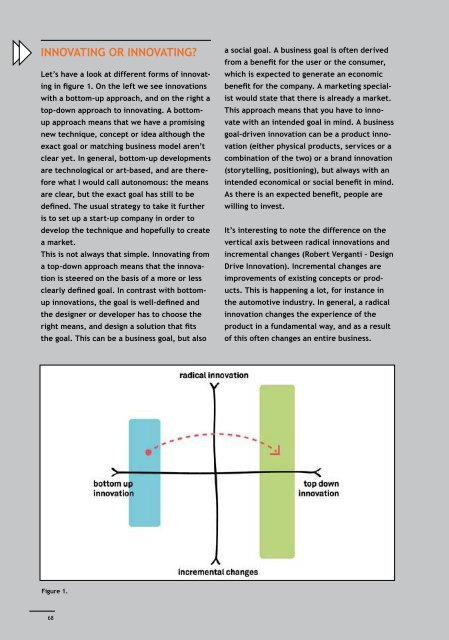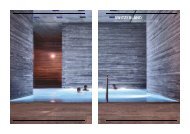download LR pdf - Kabk
download LR pdf - Kabk
download LR pdf - Kabk
You also want an ePaper? Increase the reach of your titles
YUMPU automatically turns print PDFs into web optimized ePapers that Google loves.
Innovating or innovating?Let’s have a look at different forms of innovatingin figure 1. On the left we see innovationswith a bottom-up approach, and on the right atop-down approach to innovating. A bottomupapproach means that we have a promisingnew technique, concept or idea although theexact goal or matching business model aren’tclear yet. In general, bottom-up developmentsare technological or art-based, and are thereforewhat I would call autonomous: the meansare clear, but the exact goal has still to bedefined. The usual strategy to take it furtheris to set up a start-up company in order todevelop the technique and hopefully to createa market.This is not always that simple. Innovating froma top-down approach means that the innovationis steered on the basis of a more or lessclearly defined goal. In contrast with bottomupinnovations, the goal is well-defined andthe designer or developer has to choose theright means, and design a solution that fitsthe goal. This can be a business goal, but alsoa social goal. A business goal is often derivedfrom a benefit for the user or the consumer,which is expected to generate an economicbenefit for the company. A marketing specialistwould state that there is already a market.This approach means that you have to innovatewith an intended goal in mind. A businessgoal-driven innovation can be a product innovation(either physical products, services or acombination of the two) or a brand innovation(storytelling, positioning), but always with anintended economical or social benefit in mind.As there is an expected benefit, people arewilling to invest.It’s interesting to note the difference on thevertical axis between radical innovations andincremental changes (Robert Verganti – DesignDrive Innovation). Incremental changes areimprovements of existing concepts or products.This is happening a lot, for instance inthe automotive industry. In general, a radicalinnovation changes the experience of theproduct in a fundamental way, and as a resultof this often changes an entire business.This is something Apple has achieved severaltimes, but it has also been achieved by Tom-Tom, and by Philips and Douwe Egberts withtheir Senseo coffee machine.How about AR?What about the position of Augmented Reality?To start with, the Augmented Realitytechnique is not a standalone innovation. It’snot a standalone product but a technique orfeature that can be incorporated into productsor services with a magical leverage. At its coreit is a technique that was developed — and isstill developing — with specialist purposes inmind. In principle there was no big demandfrom ‘the market’. Essentially, it is a bottomuptechnological development that needs aconcept, product or service.You can argue about whether it is an incrementalinnovation or a radical one. A virtualreality expert will probably tell you that it isan improvement (incremental innovation) ofthe VR technique. But if you look from an applicationperspective, there is a radical aspectto it. I prefer to keep the truth in the middle.At this moment in time, AR is in the blue area(figure 1).It is clear that bottom-up innovation and topdowninnovation are different species. Butwhen it comes to economic leverage, it is achallenge to be part of the top-down game.This provides a guarantee for further development,and broad acceptation of the techniqueand principles. So the major challenge for ARis to make the big step to the right part of figure1 as indicated by the red arrow. Althoughthe principles of Augmented Reality are verypromising, it’s clear we aren’t there yet. Anexample: we recently received a request to‘do something’ with Augmented Reality. Theidea was to project the result of an AR applicationonto a big wall. Suddenly it occurred tome that the experience of AR wasn’t suitableat all for this form of publishing. AR doesn’t dowell on a projection screen. It does well in theuser’s head, where time, place, reality andimagination can play an intriguing game withour senses. It is unlikely that the technique ofAugmented Reality will lead to mass consumptionas in ‘experiencing the same thing witha lot of people at the same time’. No, by theirnature, AR applications are intimate and intense,and this is one of its biggest assets.FutureWe have come a long way, and the things wecan do with AR are becoming more amazing bythe day. The big challenge is to make it applicablein relevant solutions. There’s no discussionabout the value of AR in specialist areas,such as the military industry. Institutions inthe field of art and culture have discoveredthe endless possibilities, and now it is thetime to make the big leap towards solutionswith social or economic value (the green areain figure 1). This will give the technique thechance to develop further in order to flourishat the end. From that perspective, it wouldn’tsurprise me if the first really good, efficientand economically profitable application willemerge for educational purposes.Let’s not forget we are talking about a technologythat is still in its infant years. When Ilook back at the websites we made 15 yearsago, I realize the gigantic steps we have made,and I am aware of the fact that we couldhardly imagine then what the impact of theinternet would be on society today. Of course,it’s hard to compare the concept of AugmentedReality with that of the internet, but it isa valid comparison, because it gives the samepowerless feeling of not being able to predictits future. But it will probably be bigger thanyou can imagine.Figure 1.68 69
















